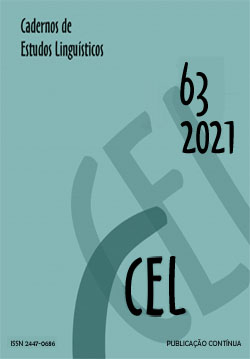Abstract
This paper aims to investigate the impressions of a group of listeners, the research judges, based on the characteristics of the caiçara speech accent by means of the application of a semantic differential questionnaire, which contains paralinguistic and extralinguistic descriptors referring to psychological, social and cultural physical and economic attributes. It is, therefore, a sociophonetic perceptive study that comprises a production task and a perception task and applies multidimensional statistical analysis to correlate quantitative and qualitative data. The results indicate that the speech of the caiçara community was considered unpleasant by the judges of all places and caused no strangeness or misunderstanding. The results of the application of the multidimensional analysis test, considering only the statistically significant variables, showed that the caiçaras speakers were judged based on the perception of their speech, as people who perform manual work, have a bad financial situation, are unsuccessful, naive, simple and humble.
References
BARBOSA, P. A. Incursões em torno do ritmo da fala. Campinas, SP: Pontes Editores; Fapesp, 2006.
BAGNO, M. Preconceito Linguístico. Como é e como se faz. São Paulo, SP: Editora Loyola, 2003.
BILIOTTI, F. CALAMAI, S. Linguistic opinions and attitudes in Tuscany: verbal guise experiments on the varieties of Arezzo and Florence. Proceedings of the Workshop “Sociophonetics, at the crossroads of speech variation, processing and communication”. Pisa, December 14th-15th, 2010. Disponível em: < https://edizioni.sns.it/en/testi-online/pdf-scaricabile.html > Acesso em: 20/07/2019.
CAMARGO, C. P. M. P. de. Territorialidades caiçaras, urbanização e turismo no município de Paraty, RJ. Boletim Campineiro de Geografia, v. 6, n. 2, 2016. Disponível em: < http://agbcampinas.com.br/bcg/index.php/boletim-campineiro/article/view/301> Acesso em: 05/05/2019.
DICIONÁRIO INFORMAL. Disponível em: https://www.dicionarioinformal.com.br/
DIEGUES, A. C. S. (Org.) Enciclopédia Caiçara, vol. 4: História e Memória Caiçara. São Paulo: NUPAUB-CEC/HUCITEC, 2005.
DIEGUES, A. C. S. A mudança como modelo cultural: O caso da cultura caiçara e a urbanização. In: Diegues, A. C. Enciclopédia Caiçara, vol. I: O olhar do pesquisador. São Paulo: NUPAUB-CEC/HUCITEC, 2004.
DIEGUES, A. C. S. Depoimento em Reportagem por Allison Almeida, André Gobi e Guilherme Rodrigues. Dossiê 193 Povos tradicionais. ComCiência. Revista eletrônica de Jornalismo Científico. 09 de novembro de 2017. Disponível em: < http://www.comciencia.br/caicaras-o-tradicional-povo-do-litoral-brasileiro/ > Acesso em: 31/11/2019.
ECKERT; P; MCCONNELL-GINET, S. Comunidades de práticas: lugar onde coabitam linguagem, gênero e poder. In: OSTERMANN, A. C.; FONTANA, B. Linguagem, sexo, sexualidade. São Paulo: Parábola Editorial, 2010. [original de 1992].
FOULKES, P. SCOBBIE, J. M. WATT, D. Sociophonetics. In William J. Hardcastle, John Laver & Fiona E. Gibbon (eds.), The handbook of phonetic sciences, 703–754. Oxford: Wiley-Blackwell, 2010.
FLYNN, N. A preliminary investigation of the sociophonetics of Nottingham adolescents. Proceedings of the Workshop “Sociophonetics, at the crossroads of speech variation, processing and communication”. Pisa, December 14th-15th, 2010. Disponível em: < https://edizioni.sns.it/en/testi-online/pdf-scaricabile.html> Acesso em: 20/09/2019.
GONÇALVES, C. S.; BRESCANCINI, C. R. Considerações sobre o papel da sociofonética. Language and Law / Linguagem e Direito, Vol. 1(2), 2014, p. 67-87. < http://hdl.handle.net/10923/10825 > Acesso em: 11/11/2019.
LABOV W. Padrões sociolinguísticos. São Paulo: Parábola, 2008.
MAEKAWA, K. Production and Perception of ‘Paralinguistic’ Information. International Conference: Speech Prosody, 2004. Disponível em: < https://www2.ninjal.ac.jp/kikuo/SP2004.pdf > Acesso em 15/10/2019.
PÉS NA AREIA – Um retrato da resistência caiçara. Roteiro, edição e direção Antonio Penedo. Documentário produzido entre janeiro e novembro de 2011. Projeto realizado com apoio do Governo de São Paulo Secretaria de Estado da Cultura - PROAC (Programa de Ação Cultural). Disponível em: https://www.youtube.com/watch?v=4GA5kl_Fb4E. 47min46.
PRESTON, D.R; ROBINSON, G. C. Dialect Perception and Attitudes to Variation. In: Ball, M. J. (ed.) Clinical Sociolinguistics. MA/Oxford: Blackwell Publishing Ltd, 2005 (Language in society, 36:133).
SILVA, J.; MEIRELES, A. Estudo sociofonético do ritmo da fala capixaba. Journal of Speech Sciences 1(1):3-13, 2011. Disponível em: <http://www.journalofspeechsciences.org > Acesso em 11/11/2019.
TARALLO, F. A pesquisa sociolinguística. 2 ed. São Paulo: Editora Ática, 1986.
TERRA CAIÇARA - Disponível em: < https://www.youtube.com/user/terracaicara >; vídeo da entrevista Artesanato 5, disponível em: <https://www.youtube.com/watch?v=vmkjHM1We9A>
THOMAS, E. R. Sociophonetics: An Introduction. Macmillan International Higher Education: 2011.

This work is licensed under a Creative Commons Attribution-NonCommercial 4.0 International License.
Copyright (c) 2021 Cadernos de Estudos Linguísticos


